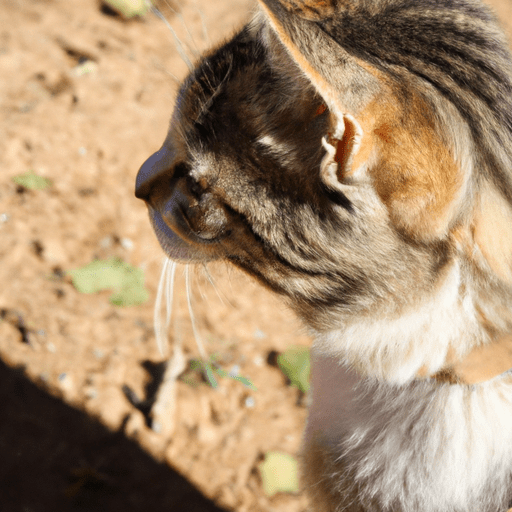If you’ve ever wondered why your furry feline friend insists on leaving their unique scent markings all over your home, fear not – you’re not alone! Cat scent marking is a natural behavior that serves a variety of purposes, from territorial communication to social bonding. In this article, we will explore the reasons behind this behavior, and most importantly, provide you with valuable tips and tricks on how to effectively curb or prevent it. So, if you’re ready to create a harmonious and scent-free environment for both you and your cat, then let’s delve into the intriguing world of cat scent marking.
Understanding Cat Scent Marking
Cat scent marking is a natural behavior that cats engage in to communicate with others. By leaving their scent in certain areas, cats are able to convey important messages to other cats and animals in their environment. Understanding why cats scent mark, where they do it, when it occurs, and how they do it can help cat owners better address and manage this behavior.
What is cat scent marking?
Cat scent marking refers to the behavior of cats depositing their scent on various surfaces. They accomplish this through spraying urine, rubbing against objects or people, and scratching. Scent marking serves as a way for cats to establish their territory, communicate their reproductive status, and reinforce social bonds.
Why do cats scent mark?
Cats scent mark for several reasons. One primary purpose is territorial marking, where cats use their scent to delineate their territory and prevent conflicts with other cats. Scent marking also plays a role in sexual communication, helping cats indicate their readiness to mate. Additionally, cats may engage in social scent marking to strengthen bonds and communicate with other cats in their social group.
Where do cats scent mark?
Cats can scent mark in various locations both indoors and outdoors. Common areas that cats choose to mark include doorways, windows, furniture, walls, and objects around the house. They may also mark trees, fences, and other outdoor structures. The specific areas chosen for scent marking often relate to a cat’s territorial boundaries or areas where they spend a significant amount of time.
When do cats scent mark?
Cats can scent mark at any age, although the behavior is more commonly observed in sexually mature cats. Unneutered male cats, in particular, are more likely to engage in scent marking due to their higher level of testosterone. However, both male and female cats may scent mark when they feel threatened, anxious, or when there are changes in their environment.
How do cats scent mark?
Cats employ different methods to scent mark. One method is spraying, where cats release a small amount of urine onto vertical surfaces, such as walls or furniture. Spraying is typically more common in unneutered males, but some females may also engage in this behavior. Another method is rubbing, where cats use the glands located on their face, chin, and paws to deposit their scent when they rub against objects or people. Finally, scratching serves as a form of scent marking, as cats have scent glands in their paws that leave their scent on the surfaces they scratch.
Types of Cat Scent Marking
Understanding the different types of cat scent marking can help cat owners identify and address specific behaviors more effectively.
Spraying
Spraying is a form of cat scent marking where the cat releases a small amount of urine onto vertical surfaces. It is often done on walls, furniture, or other objects that serve as territorial boundaries. The urine contains pheromones that convey important messages to other cats, such as the cat’s presence, reproductive status, or territorial claim.
Rubbing
Rubbing is another common form of scent marking. Cats have scent glands on their face, chin, and paws, which they use to leave their scent when they rub against surfaces or people. By rubbing, cats communicate their presence and establish their territory. This behavior can often be observed when cats rub against furniture, doors, or even their owners.
Scratching
Scratching serves multiple purposes for cats, including scent marking. Cats have scent glands in their paws, and when they scratch a surface, they leave their scent behind. By scratching, cats communicate their presence to other cats and mark their territory. Additionally, scratching also helps cats maintain the condition of their claws and stretch their bodies.
Reasons for Cat Scent Marking
Understanding the reasons behind cat scent marking is crucial for addressing and managing this behavior effectively.
Territorial marking
Territorial marking is one of the primary reasons cats scent mark. By depositing their scent, cats establish and defend their territory. This helps reduce conflicts with other cats by communicating boundaries and preventing territorial disputes.
Sexual marking
Sexual marking is a component of cat scent marking behavior related to mating. Female cats in heat often engage in scent marking to attract potential mates. Additionally, unneutered male cats may use scent marking to indicate their reproductive status and to communicate with other cats.
Social marking
Scent marking also plays a role in social communication among cats. It helps cats establish and reinforce social bonds within their group. By leaving their scent on objects or other cats, cats can convey information about their presence, comfort, and willingness to engage in social interactions.
Identifying Cat Scent Marking
Being able to identify specific behaviors associated with cat scent marking is crucial for addressing the issue effectively.
Signs of scent marking behavior
There are several signs that indicate a cat may be engaging in scent marking behavior. One common sign is spraying, where cats will stand upright and release a small amount of urine against vertical surfaces. Another sign is rubbing, where cats rub their face or body against objects or people to leave their scent. Additionally, scratching furniture or other surfaces is also a form of scent marking.
Differentiating scent marking from other behaviors
It’s important to differentiate scent marking from other behaviors, such as inappropriate elimination or territorial aggression. Inappropriate elimination refers to when cats urinate outside the litter box, while territorial aggression involves aggressive behavior towards other cats. Scent marking is typically a specific behavior characterized by spraying, rubbing, or scratching on objects and surfaces, rather than random or indiscriminate elimination.
The Impact of Cat Scent Marking
Cat scent marking can have various impacts on both the cat and its environment. Understanding these impacts can help guide efforts to address and manage scent marking behavior.
Odor concerns
One of the main concerns associated with cat scent marking is the lingering odor. The urine used in spraying can have a strong, unpleasant smell that can be difficult to remove. This can create an unpleasant living environment for cat owners and may lead to tension within the household.
Stress and anxiety
Scent marking can be a sign of stress or anxiety in cats. Factors such as changes in the environment, introduction of new pets, or the presence of outdoor cats may trigger scent marking behavior. Addressing the underlying causes of stress and providing a calm and secure environment can help reduce scent marking incidents.
Social conflicts with other pets
Cat scent marking can lead to social conflicts with other pets, particularly if they are not familiar with the scent marking cat. This can result in territorial disputes or aggressive behavior between animals. Proper introductions, gradual acclimation, and providing separate spaces can help prevent or mitigate such conflicts.
Preventing Cat Scent Marking
While it may not always be possible to eliminate scent marking behavior entirely, there are several measures cat owners can take to minimize and prevent it.
Neutering or spaying your cat
One effective way to reduce scent marking behavior is to have your cat neutered or spayed. This helps reduce the amount of hormones, particularly testosterone, in the cat’s body, which can decrease territorial and sexual marking behaviors.
Creating a suitable litter box setup
Ensuring a suitable litter box setup is essential for preventing inappropriate elimination and potential scent marking. Providing enough litter boxes in separate locations, keeping them clean, and using unscented litter can help encourage proper toileting behavior.
Ensuring environmental enrichment
Providing a stimulating and enriched environment for your cat can help reduce stress and anxiety, which are common triggers for scent marking. This includes offering toys, scratching posts, perches, and interactive play sessions to keep your cat mentally and physically stimulated.
Using deterrents
Using deterrents, such as pheromone-based sprays or motion-activated devices, can help discourage cats from scent marking in unwanted areas. These products work by creating an unpleasant association with the marked area, discouraging the cat from returning to scent mark.
Behavior modification techniques
Behavior modification techniques, such as positive reinforcement and redirecting the cat’s behavior, can be effective in managing and preventing scent marking. Rewarding desired behaviors, such as using the litter box, and redirecting the cat’s attention to appropriate alternatives can help reshape their behavior.
Addressing Cat Scent Marking Issues
When faced with cat scent marking issues, there are several strategies that can be employed to address the problem effectively.
Cleaning and removing scent marks
Cleaning and removing scent marks is an essential step in managing cat scent marking. Using enzymatic cleaners specifically designed to eliminate pet odors can help remove lingering scents. It’s important to thoroughly clean affected areas to deter the cat from returning to the same spot.
Implementing positive reinforcement
Implementing positive reinforcement can help discourage scent marking and encourage desirable behaviors. Rewarding your cat with treats or praise when they use the litter box or exhibit appropriate behaviors can help reinforce those behaviors and steer them away from scent marking.
Seeking professional help
In some cases, cat scent marking issues may require professional assistance. Consulting with a veterinarian or a professional animal behaviorist can help identify underlying causes, develop a customized behavior modification plan, and provide guidance on managing the behavior effectively.
Understanding Medical Causes
In certain instances, scent marking behavior may be related to underlying medical conditions. It’s important to rule out any potential medical causes before addressing the behavior.
Rule out medical conditions
Some medical conditions, such as urinary tract infections or bladder issues, can lead to inappropriate elimination or an increase in scent marking behavior. Consulting with a veterinarian to rule out any medical conditions is crucial in determining the best approach to address scent marking.
Consulting with a veterinarian
If you suspect medical causes may be contributing to your cat’s scent marking behavior, it’s important to consult with a veterinarian. They can conduct a thorough examination, run necessary tests, and provide appropriate treatment or management strategies if a medical condition is identified.
Conclusion
Understanding and addressing cat scent marking is essential for creating a harmonious and stress-free home environment for both cats and their owners. By recognizing the reasons behind scent marking, implementing prevention strategies, and seeking professional help when needed, cat owners can effectively manage this behavior and promote a peaceful coexistence.








